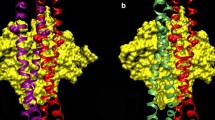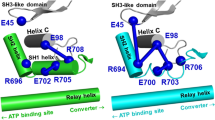Abstract
In this chapter, we discuss the role of water in actomyosin-force generation. We have been investigating the hydration properties of ions, organic molecules, and proteins. These studies revealed that actin filaments (F-actin) are surrounded by a hyper-mobile water (HMW) layer and restrained water layer, while myosin subfragment 1 (S1) has only a typical restrained hydration layer. The understanding of the physicochemical properties of HMW has been greatly advanced by recent theoretical studies on statistical mechanics and solution chemistry. To explain the mechanism of force generation of actomyosin using ATP hydrolysis, we propose a driving force hypothesis based on novel intermolecular surface force. This hypothesis is consistent with the reported biochemical kinetics and thermodynamic parameters for the primary reaction steps. The gradient field of solvation free energy of S1 is generated in close proximity to F-actin.
Access this chapter
Tax calculation will be finalised at checkout
Purchases are for personal use only
Similar content being viewed by others
References
Asakura S, Oosawa F (1954) On interaction between two bodies immersed in a solution of macromolecules. J. Chem. Phys. 22:1255–1256
Bagshaw CR, Trentham DR (1974) The characterization of Myosin-product complexes and of product-release steps during the magnesium ion-dependent adenosine triphosphatase reaction. Biochem J 141:331–349
Best RB, Zhu X, Shim J, Lopes PEM, Mittal J, Feig M, MacKerell Jr AD (2012) Optimization of the additive CHARMM all-atom protein force field targeting improved sampling of the backbone φ, ψ and side-chain χ1 and χ2 dihedral angles. J Chem Theory Comput 8:3257–3273
Brooks BR, Bruccoleri RE, Olafson BD, States DJ, Swaminathan S, Karplus M (1983) CHARMM: a program for macromolecular energy, minimization, and dynamics calculations. J Comput Chem 4:187–217
Brünger A, Brooks IIICL, Karplus M (1984) Stochastic boundary conditions for molecular dynamics simulations of ST2 water. Chem Phys Lett 105:495–500
Chauwin JF, Ajdari A, Prost J (1994) Force-free motion in asymmetric structures: a mechanism without diffusive steps. Europhys Lett 27:421–426
Edmann KAP (1988) Double hyperbolic force-velocity relation in frog muscle fibers. J Physiol 404:301–321
Egelman EH, Orlova A (1995) New insights into actin filament dynamics. Curr Opin Struct Biol 5:172–180
Essmann U, Perera L, Berkowitz ML, Darden T, Lee H, Pedersen JG (1995) A smooth particle mesh Ewald method. J Chem Phys. 103:8577–8593
Feller SE, Zhang Y, Pastor RW, Brooks BR (1995) Constant pressure molecular dynamics simulation: The Langevin Piston method. J Chem Phys 103:4613–4621
Fiorin G, Klein ML, Hénin J (2013) Using collective variables to drive molecular dynamics simulations. Mol Phys 111:3345–3362
Fujii T, Namba K (2017) Structure of actomyosin rigour complex at 5.2 Å resolution and insights into the ATPase cycle mechanism. Nat Commun 8 (1–11):13969
Galkin VE, Orlova1 A, Schröder GF, Egelman EH (2010) Structural polymorphism in F-actin. Nat Struct Mol Biol 17:1318–1324
Greene LE, Eisenberg E (1980) Dissociation of the Actin ~ Subflagment1 Complex by Adeny1-5’-yl Imidodiphosphate, ADP, and PPi. J Biol Chem 255:543–548
Hibberd MG, Dantzig JA, Trentham DR, Goldman YE (1985) Phosphate release and force generation in skeletal muscle fibers. Science 228:1317–1319
Hirakawa R, Nishikawa Y, Uyeda TQP, Tokuraku K (2017) Unidirectional growth of HMM clusters along actin filaments revealed by real time fluorescence microscopy. Cytoskeleton 74:482–489. https://doi.org/10.1002/cm.21408
Hornak V, Abel R, Okur A, Strockbine B, Roitberg A, Simmerling C (2006) Comparison of multiple Amber force fields and development of improved protein backbone parameters. Proteins Struct Funct, Bioinf 65:712–725
Inoue A, Tonomura Y (1980) Dissociation of Acto ~ H-Meromyosin and That of Acto-Subfragment-l Induced by Adenyl-5’-yl-imidodiphosphate: Evidence for a Ternary Complex of F-Actin, Myosin Head, and Substrate. J Biochem 88:1643–1651
Ishijima A, Doi T, Sakurada K, Yanagida T (1991) Sub-piconewton force fluctuations of actomyosin in vitro. Nature 352:301–306
Jorgensen WL, Chandrasekhar J, Madura JD, Impey RW, Klein ML (1983) Comparison of simple potential functions for simulating liquid water. J Chem Phys 79:926–935
Kabir SR, Yokoyama K, Mihashi K, Kodama T, Suzuki M (2003) Hyper-mobile water is induced around actin filaments. Biophys J 85:3154–3161
Karino Y, Matubayasi N (2011) Communication: free-energy analysis of hydration effect on protein with explicit solvent: equilibrium fluctuation of cytochrome c. J Chem Phys 134(1–11):041105
Kawai M, Halvorson HR (1991) Two step mechanism of phosphate release and the mechanism of force generation in chemically skinned fibers of rabbit psoas muscle. Biophys J 59:329–342
Kinoshita M (2009) Importance of translational entropy of water in biological self-assembly processes like protein folding. Int J Mol Sci 10:1064–1080
Kinoshita M, Suzuki M (2009) A statistical-mechanical analysis on the hypermobile water around a large solute with high surface charge density. J Chem Phys 130(1–11):014707
Kitamura K, Tokunaga M, Iwane AH, Yanagida T (1999) A single myosin head moves along an actin filament with regular steps of 5.3 nanometres. Nature 397(6715):129–134
Kodama T (1985) Thermodynamic analysis on muscle ATPase mechanisms. Physiol Rev 65:467–551
Kubota Y, Yoshimori A, Matubayasi N, Suzuki M, Akiyama R (2012) Molecular dynamics study of fast dielectric relaxation of water around a molecular-sized ion. J Chem Phys 137(1–4):224502
Lawson JD, Pate E, Rayment I, Yount RG (2004) Molecular dynamics analysis of structural factors influencing the Pi-release tunnel in myosin. Biophys J 86:3794–3803
MacKerell AD Jr, Bashford D, Bellott M, Dunbrack RL Jr, Evanseck JD, Field MJ, Fischer S, Gao J, Guo H, Ha S et al (1998) All-atom empirical potential for molecular modeling and dynamics studies of proteins. J Phys Chem B 102:3586–3616
Margossian SS, Lowey S (1982) Preparation of myosin and its subfragments from rabbit skeletal muscle. San Diego, California: Elsevier, Inc. Methods Enzymol 85 Pt B:55–71
Martyna GJ, Tobias DJ, Klein ML (1994) Constant pressure molecular dynamics algorithms. J Chem Phys 101:4177–4189
Miyamoto S, Kollman PA (1992) SETTLE: an analytical version of the SHAKE and RATTLE algorithm for rigid water models. J Comput Chem 13:952–962
Miyazaki T, Wazawa T, Mogami G, Kodama T, Suzuki M (2008) Measurement of the dielectric relaxation property of water-ion loose complex in aqueous solutions of salt at low concentrations. J Phys Chem A 112:10801–10806
Mogami G, Wazawa T, Morimoto N, Kodama T, Suzuki M (2011) Hydration properties of adenosine phosphate series as studied by microwave dielectric spectroscopy. Biophys Chem 154:1–7
Mogami G, Miyazaki T, Wazawa T, Matubayasi N, Suzuki M (2013) Anion-dependence of fast relaxation component in Na-, K-halide solutions at low concentrations measured by high-resolution microwave dielectric spectroscopy. J Phys Chem A 117:4851–4862
Mogami G, Suzuki M, Matubayasi N (2016) Spatial-decomposition analysis of energetics of ionic hydration. J Phys Chem B 120:1813–1821
Muretta JM, Petersen KJ, Thomas DD (2013) Direct real-time detection of the actin-activated power stroke within the myosin catalytic domain. Proc Natl Acad Sci USA 110:7211–7216
Muretta JM, Rohde JA, Johnsrud DO, Cornea S, Thomas DD (2015) Direct real-time detection of the structural and biochemical events in the myosin powerstroke. Proc Natl Acad Sci USA 112:14272–14277
Ngo KX, Kodera N, Katayama E, Ando T, Uyeda TQP (2015) Cofilin-induced unidirectional cooperative conformational changes in actin filaments revealed by high-speed atomic force microscopy. eLife(1–22):4:e04806
Oda T, Maeda Y (2010) Multiple conformations of F-actin. Structure 18:761–767
Oobatake M, Ooi T (1988) Characteristic thermodynamic properties of hydrated water for 20 amino acid residues in globular proteins. J Biochem 104:433–439
Oobatake M, Ooi T (1993) Hydration and heat stability effects on protein unfolding. Prog Biophys Mol Biol 59:237–284
Ohno T, Kodama T (1991) Kinetics of adenosine triphosphate hydrolysis by shortening myofibrils from rabbit psoas muscle. J Physiol 441:685–702
Phillips JC, Braun R, Wang W, Gumbart J, Tajkhorshid E, Villa E, Chipot C, Skeel RD, Kale L, Schulten K (2005) Scalable molecular dynamics with NAMD. J Comput Chem 26:1781–1802
Prochniewicz E, Thomas DD (1997) Perturbations of functional interactions with myosin induce long-range allosteric and cooperative structural changes in actin. Biochemistry 36:12845–12853
Sakuraba S, Matubayasi N (2014) ERmod: fast and versatile computation software for solvation free energy with approximate theory of solutions. J Comp Chem 35:1592–1608
Siddique MSP, Mogami G, Miyazaki T, Katayama E, Uyeda TQP, Suzuki M (2005) Cooperative structural change of actin filaments interacting with activated myosin motor domain, detected with copolymers of pyrene-labeled actin and acto-S1 chimera protein. Biochem Biophys Res Commun 337:1185–1191
Spudich JA, Watt S (1971) The regulation of rabbit skeletal muscle contraction. 1. Biochemical studies of the interaction of the tropomyosin-troponin complex with actin and the proteolytic fragments of myosin. J Biol Chem 246:4866–4871
Stein LA, Chock PB, Eisenberg E (1981) Mechanism of the actomyosin ATPase: effect of actin on ATP hydrolysis step. Proc Natl Acad Sci USA 78:1346–1350
Stein LA, Chock PB, Eisenberg E (1984) The rate-limiting step in the actomyosin adenosinetriphosphate cycle. Biochemistry 23:1555–1563
Suzuki M (1994) New concept of a hydrophobicity motor based on local hydrophobicity transition of functional polymer substrate for micro/nano machines. Polym Gels Networks 2:279–287
Suzuki M, Shigematsu J, Kodama T (1996) Hydration study of proteins in solution by microwave dielectric analysis. J Phys Chem 100:7279–7282
Suzuki M (2004) Actomyosin motor mechanism: affinity gradient surface force model. Prog Coll Polym Sci 125:38–41
Suzuki M, Kabir SR, Siddique MSP, Nazia US, Miyazaki T, Kodama T (2004) Myosin-induced volume increase of the hyper-mobile water surrounding actin filaments. Biochem Biophys Res Commun 322:340–346
Suzuki M (2014) What is “hypermobile” water?: detected in alkali halide, adenosine phosphate and F-actin solutions by high-resolution microwave dielectric spectroscopy. Pure Appl Chem 86:181–189
Suzuki M, Imao A, Mogami G, Chishima R, Watanabe T, Yamaguchi T, Morimoto N, Wazawa T (2016) Strong dependence of hydration state of F-actin on the bound Mg2+/Ca2+ ions. J Phys Chem B 120:6917–6928
Suzuki M, Mogami G, Ohsugi H, Watanabe T, Matubayasi N (2017) Physical driving force of actomyosin motility based on the hydration effect. Cytoskeleton 74:512–527. https://doi.org/10.1002/cm.21417
Szent-Gyorgyi A (1951) Nature of the contraction of muscle. Nature 4245(1951):380–381
Szent-Gyorgyi A (1956) Bioenerg Sci 124:873–875
Takagi Y, Shuman H, Goldman YE (2004) Coupling between phosphate release and force generation in muscle actomyosin. Philos Trans R Soc Lond B Biol Sci 359:1913–1920
Takashima S (2002) Electric dipole moments of globular proteins: measurement and calculation with NMR and X-ray databases. J Non-Cryst Solids 305:303–310
Taylor EW (1977) Transient phase of adenosine triphosphate hydrolysis by myosin, heavy meromyosin, and head. Biochemistry 17:732–740
UCSF Chimera. http://www.cgl.ucsf.edu/chimera/. Accessed 18 July 2017
Van Gunsteren WF, Berendsen HJC (1988) A Leap-frog algorithm for stochastic dynamics. Mol Simul 1:173–185
Volkmann N, Ouyang G, Trybus KM, DeRosier DJ, Lowey S, Hanein D (2003) Myosin isoforms show unique conformations in the actin-bound state. Proc Nat Acad Sci USA 100:3227–3232
Wazawa T, Sagawa T, Ogawa T, Morimoto N, Suzuki M (2011) Hyper-mobility of water around actin filaments revealed using pulse-field gradient spin-echo 1H-NMR and fluorescence spectroscopy. Biochem Biophys Res Commun 404:985–990
Webb MR, Hibberd MG, Goldman YE, Trentham DR (1986) Oxygene exchange between Pi in the medium and water during ATP hydrolysis mediated by skinned fibers from rabbit skeletal muscle: evidence for Pi binding to a force-generating state. J Biol Chem 261:15557–15564
Woledge RC, Curtin NA, Homsher E (1985) Energetic aspects of muscle contraction, Chap 3. Academic Press, London, pp 119–165
Yamamori Y, Ishizuka R, Karino Y, Sakuraba S, Matubayasi N (2016) Interaction-component analysis of the hydration and urea effects on cytochrome c. J Chem Phys 144:085102
Yanagida T, Arata T, Oosawa F (1985) Sliding distance of actin filament induced by a myosin crossbridge during one ATP hydrolysis cycle. Nature 316:366
Yokoyama K, Kamei T, Minami H, Suzuki H (2001) Hydration study of globular proteins by microwave dielectric spectroscopy. J Phys Chem B 105:12622–12627
Author information
Authors and Affiliations
Corresponding author
Editor information
Editors and Affiliations
Rights and permissions
Copyright information
© 2018 Springer Nature Singapore Pte Ltd.
About this chapter
Cite this chapter
Suzuki, M., Mogami, G., Watanabe, T., Matubayasi, N. (2018). Novel Intermolecular Surface Force Unveils the Driving Force of the Actomyosin System. In: Suzuki, M. (eds) The Role of Water in ATP Hydrolysis Energy Transduction by Protein Machinery. Springer, Singapore. https://doi.org/10.1007/978-981-10-8459-1_16
Download citation
DOI: https://doi.org/10.1007/978-981-10-8459-1_16
Published:
Publisher Name: Springer, Singapore
Print ISBN: 978-981-10-8458-4
Online ISBN: 978-981-10-8459-1
eBook Packages: Chemistry and Materials ScienceChemistry and Material Science (R0)




